Physical Address
304 North Cardinal St.
Dorchester Center, MA 02124
The temporal bone consists of four embryologically distinct components: these are squamous, mastoid, petrous, and tympanic .
The temporal line is located approximately 5 mm inferior to the lowest level of the middle fossa floor.
The mastoid antrum is located deep to the depressed cribriform area located posterior to the spine of Henle, known as the MacEwen triangle .
The stylomastoid foramen is located at the anterior limit of the digastric groove.
The arcuate eminence is the prominence of the superior semicircular canal on the middle fossa floor.
Potential paths of tumor spread from the external auditory canal include the bony-cartilaginous junction, the foramen of Huschke, and the fissures of Santorini.
The outer and middle ears are derived from the first and second branchial grooves and pouches. The middle ear structures arise from the corresponding arches.
The epitympanum and mesotympanum are separated by the ossicular chain and associated mucosal folds, leaving only narrow apertures for air supply to the attic and antrum.
Middle ear landmarks of the facial nerve include the cochleariform process, oval window, and pyramidal eminence.
The most vulnerable portion of the ossicular chain is the long process of the incus, which possesses a single nutrient vessel and lacks collateral circulation.
The supratubal recess, located at the anterior extreme of the attic and superior to the opening of the eustachian tube, is a site in which cholesteatoma or blind surgical dissection can injure the facial nerve. The geniculate ganglion is located just deep to its medial wall and may be dehiscent.
The labyrinthine segment of the facial nerve is particularly vulnerable to injury because of watershed vertebrobasilar/external carotid circulation, a narrow bony canal, and proximity to genicular ganglion, where herpetic infections and traumatic distortion of thin surrounding bone may produce nerve swelling and entrapment in the labyrinthine segment.
Multiple intracranial and extracranial regions interface with the temporal bone, the anatomy of which reflects its unique role in the embryology of the head and neck and in the transit of vessels, nerves, and pathogens through these regions. An understanding of this anatomy is required to identify the etiology and the safe and effective treatment of diseases of the ear. This chapter presents anatomic features of the ear that inform the clinician's understanding of disease and surgical management. More detailed descriptions of structure can be found in cited references.
The temporal bone articulates with the sphenoid, parietal, occipital, and zygomatic bones and therefore contributes to the cranial, skull base, and facial structure. The temporal bone has a pyramidal shape, the sides of which form the middle fossa floor (superior face), the anterior limit of the posterior fossa (posterior face), muscle attachments of the neck and infratemporal fossa (anterior-inferior face), and the muscular-cutaneous covered side of the head (lateral), which forms the base of the pyramid. The temporal bone consists of four embryologically distinct components: the squamous, mastoid, petrous, and tympanic parts.
The squamous part forms the lateral wall of the middle fossa ( Fig. 126.1 ). It consists of a plate of bone with an anterior extension known as the zygomatic process, which forms the bony roof of the glenoid fossa. The temporalis muscle inserts onto the outer cortex, whereas the masseter muscle inserts on the zygomatic process. A horizontal ridge, known as the temporal line, is formed along the most inferior insertion by the temporalis muscle; it is aligned with the zygomatic process and is used as a surface landmark to estimate the location of the middle fossa floor, with an average offset of approximately 4.7 mm.
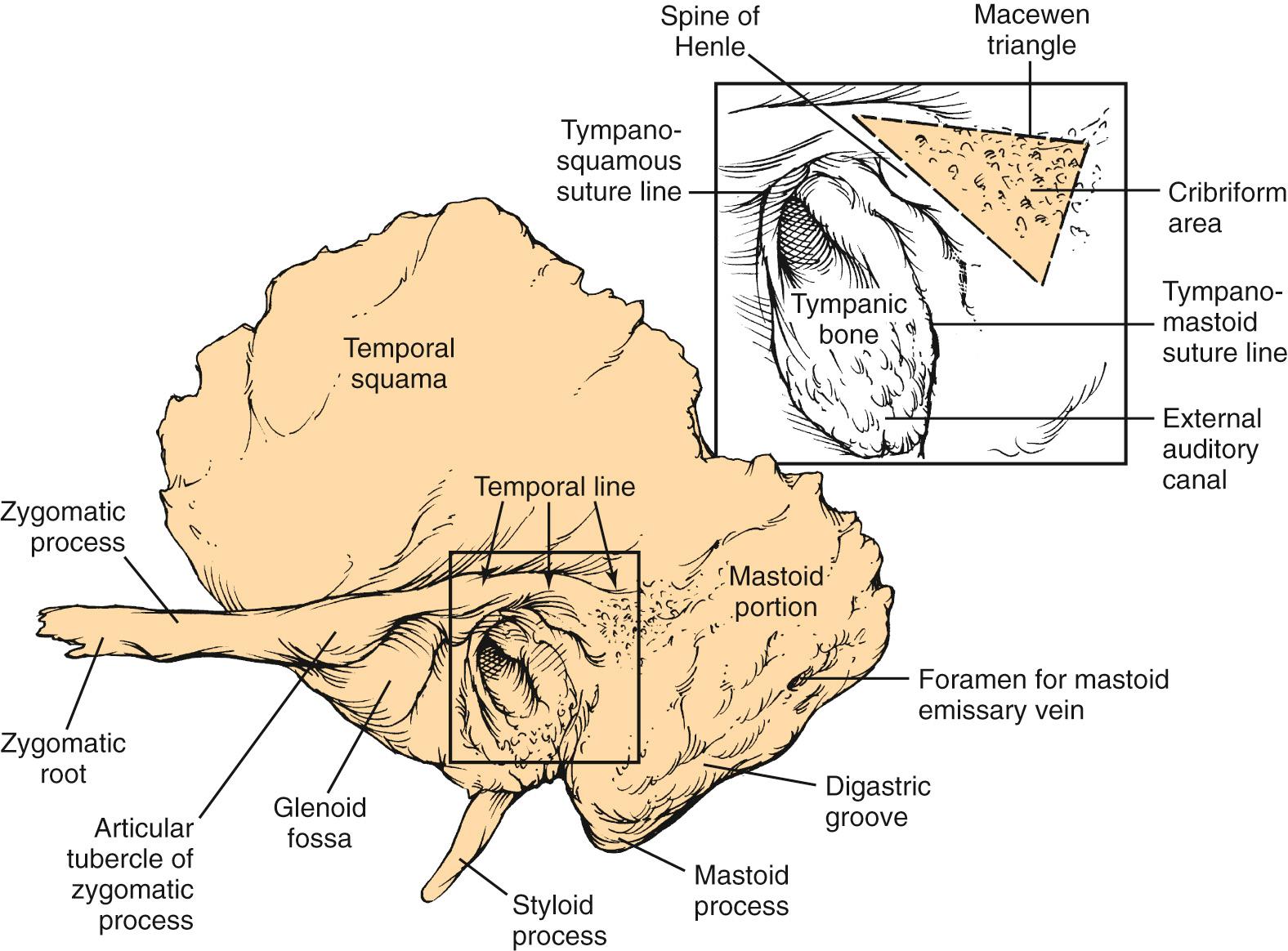
The mastoid part of the temporal bone is a bulbous bony structure shaped by the expansion of air-filled spaces within (see Fig. 126.1 ). The constant pull by the sternocleidomastoid (SCM) and posterior belly of the digastric muscles elongates the mastoid inferiorly to form the mastoid tip, or mastoid process. The mastoid cortex is perforated by multiple small emissary vessels that drain from the central air cell, or antrum, and form a depressed cribriform area at the anterior junction of the mastoid process with the tympanic bone. The foramen of a single emissary vein is evident near the posterior limit of the outer mastoid cortex, and it communicates with the sulcus of the sigmoid sinus, which is evident on the posterior medial aspect of the temporal bone. The site of SCM insertion is indicated by a rough and irregular surface at the mastoid tip. Medial to the mastoid tip, the posterior belly of the digastric muscle is inserted in a sulcus that terminates anteriorly at the stylomastoid foramen. Medial and almost parallel to the digastric sulcus is the sulcus for the occipital artery.
The petrous part of the temporal bone has the shape of a pyramid whose base is united with the mastoid laterally; the apex is oriented anteromedially between the occipital and sphenoid bones. The anterior surface forms the posteromedial margin of the middle fossa floor ( Fig. 126.2 ). Significant surface features include, medially, the arcuate eminence, formed by the prominence of the superior semicircular canal (SCC), and the sulcus of the superior petrosal sinus. Anteriorly, at the junction with the greater sphenoid wing, the musculotubal canal contains the more superficial semicanal of the tensor tympani and a deeper semicanal of the eustachian tube (ET). At the bone's apex, a smooth depression is occupied by the trigeminal ganglion, just posterior to which are located foramina and sulci of the greater and lesser superficial petrosal nerves, running parallel to the sphenoid suture line. The roof of the middle ear and mastoid is located lateral to the arcuate eminence; the posterior surface of the petrous part of the temporal bone is oriented in the vertical plane that forms the anterior bony limit of the posterior fossa ( Fig. 126.3 ). This surface is framed by sulci for the sigmoid, superior petrosal, and inferior petrosal sinuses. At the center of the posterior face is the porus acusticus, at the fundus of which can be seen the falciform (horizontal) crest, Bill's bar (vertical crest), and foramina of cranial nerves VII and VIII. The subarcuate artery emerges from a depression superior and lateral to the acoustic meatus, whereas the endolymphatic sac and duct occupy the depression and opening located inferolaterally, known as the operculum. The jugular foramen is formed at the junction between the petrous and occipital bones ( Fig. 126.4 ), and it is partitioned into the pars nervosa (posterior) and pars venosa (anterior) by the jugular spine. The inferior surface of the temporal bone is irregular because of the presence of multiple muscle attachments ( Fig. 126.5 ). The external aperture to the cochlear aqueduct is located just medial and anterior to the jugular spine within the pars nervosa, and it marks the most superior limit of the jugular foramen. The glossopharyngeal nerve enters the jugular foramen adjacent to the opening of the cochlear aqueduct. In the translabyrinthine approach to the internal auditory canal (IAC), the cochlear aqueduct is an important inferior limit of dissection used to protect the lower cranial nerves. The cochlear aqueduct eventually opens into the scala tympani at the cochlear base. The jugular bulb occupies a dome-shaped compartment located lateral to the pars venosa of the jugular foramen, directly under the middle ear space. The inferior foramen of the carotid canal is located directly anterior to the jugular bulb depression, from which it is separated by a wedge-shaped bone called the keel. The tympanic canaliculus penetrates the keel to transmit sensory and preganglionic parasympathetic fibers from the inferior ganglion of the glossopharyngeal nerve into the middle ear as the Jacobson nerve. The styloid process is located anterior to the stylomastoid foramen, and both are located at the anterior limit of the digastric groove. Elongation or angulation of the styloid process can produce the triad of odynophagia, dysphagia, and foreign body sensation in the throat, known as Eagle syndrome, as a result of the compression of cranial nerves or the internal carotid artery.
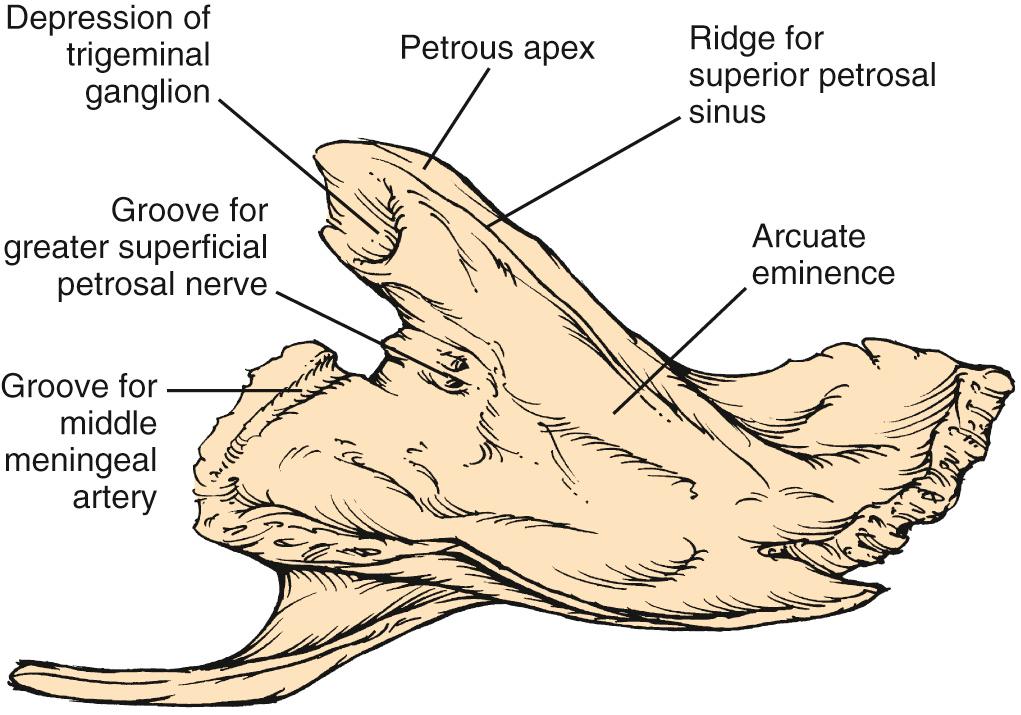
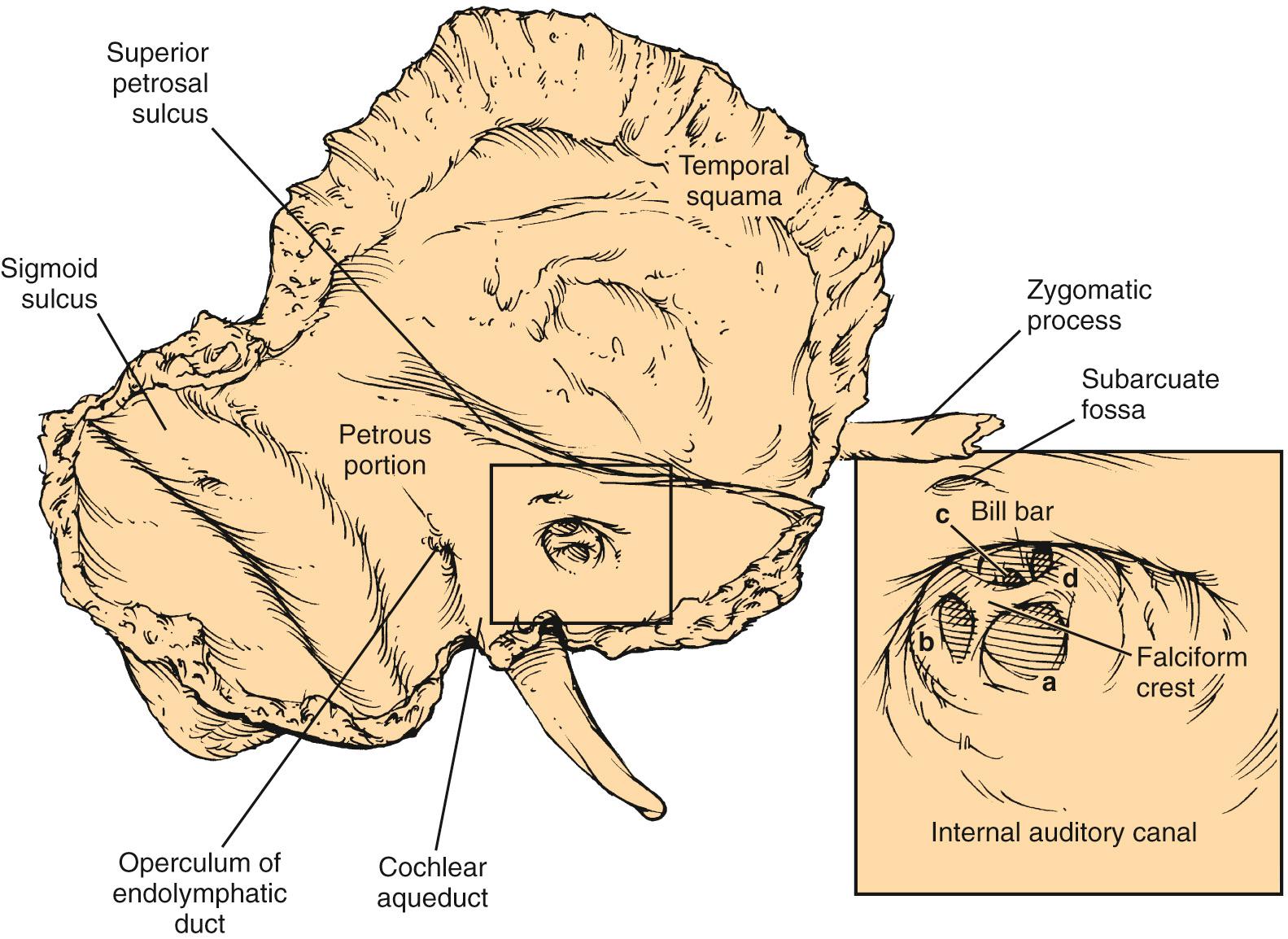
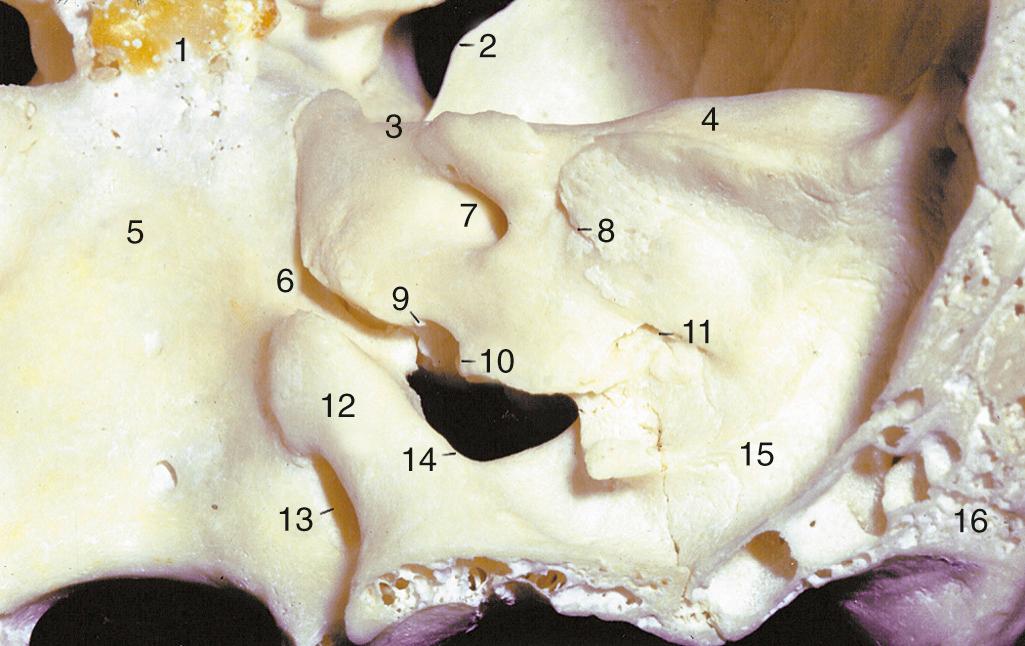
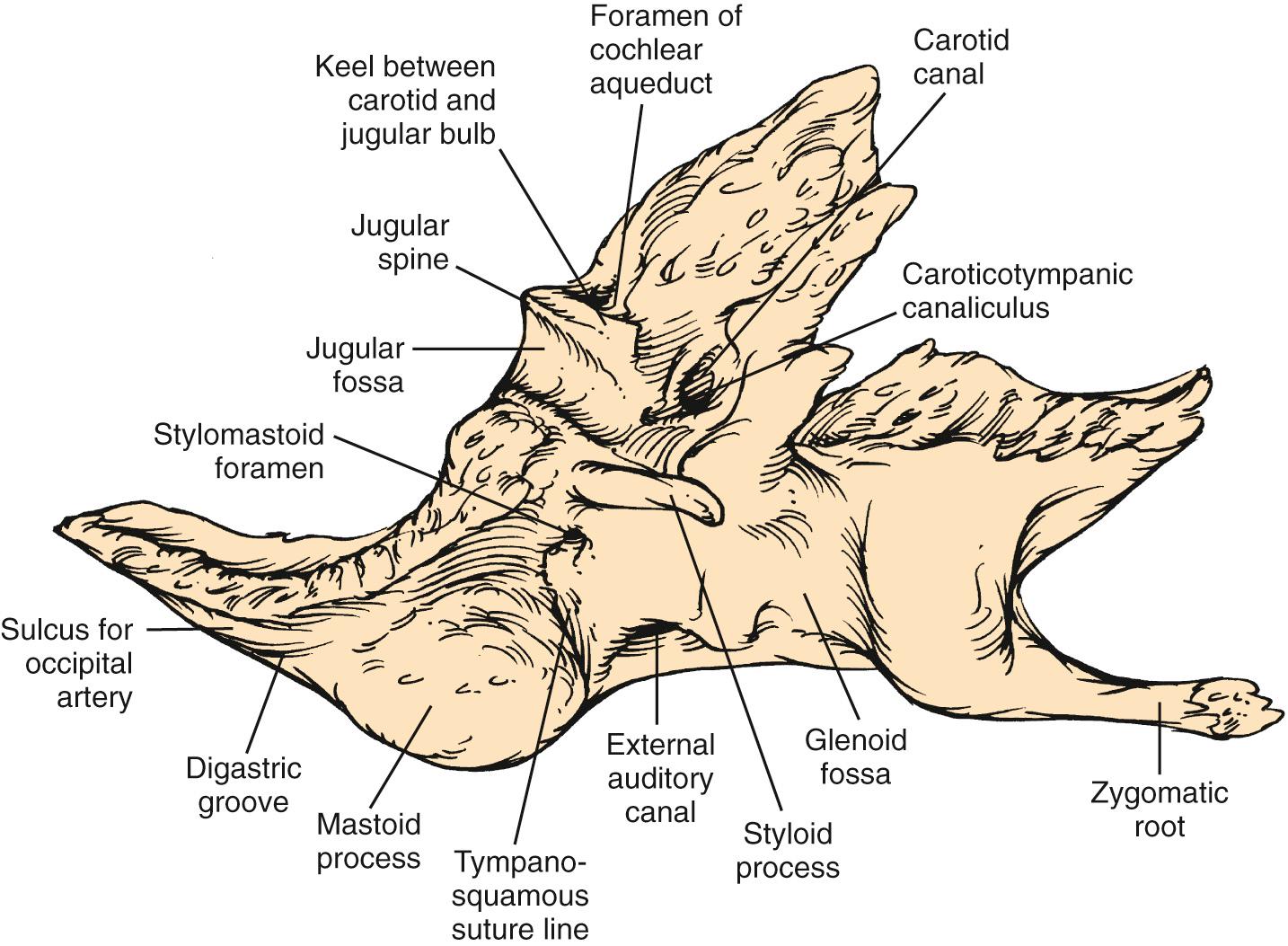
The tympanic part of the temporal bone forms the anterior wall and floor and part of the posterior wall and roof of the bony external auditory canal (EAC) and the anterior wall and floor of the middle ear (see Fig. 126.1 ). The anterior edge of this open ring forms the tympanosquamous suture line within the EAC and the petrotympanic suture line within the middle ear, through which the chorda tympani exits the ear. The posterior edge of the tympanic ring forms the tympanomastoid suture line that curves from the posterior EAC inferiorly to within millimeters of the stylomastoid foramen; this line serves as a landmark for the main trunk of the facial nerve, as it exits the temporal bone (see Fig. 126.5 ).
Become a Clinical Tree membership for Full access and enjoy Unlimited articles
If you are a member. Log in here